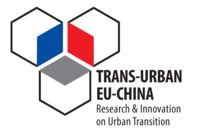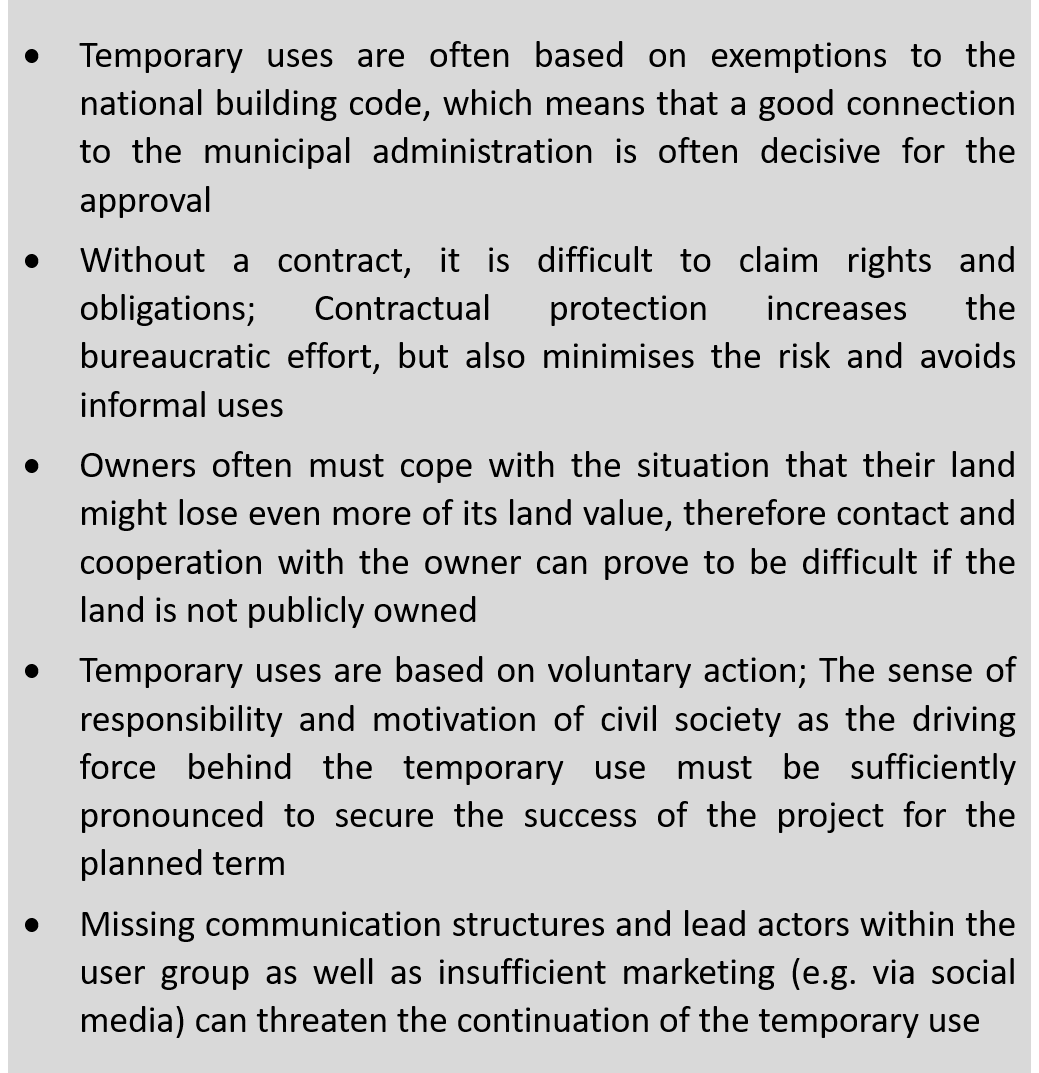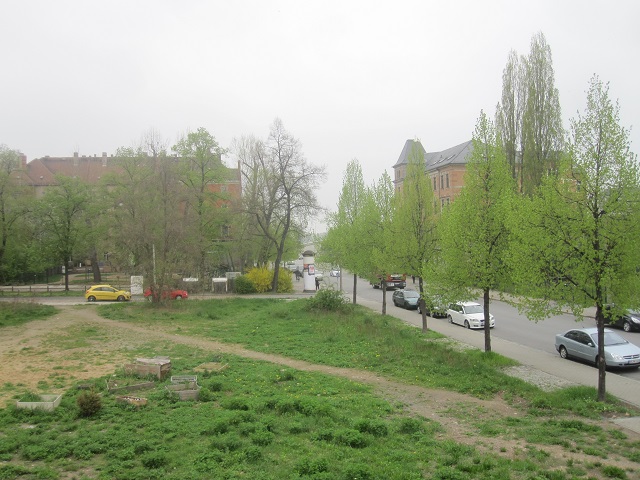
TRANS-URBAN-EU-CHINA
Transition towards urban sustainability through socially integrative cities in the EU and in China
TEMPORAY USE
1. Purpose(s)
A temporay (or interim) use represents an urban development instrument, which is used to revitalise an urban brownfield/plot of derelict land or dilapidated (industrial) buildings for a limited period of time until a permanent new function can be established on the plot (Coutinue reading Participatory Urban Gardening; Figure 1 to 3). Reasons for temporay use are usually the desire to make the area accessible again (destigmatisation of former industrial or military use) and to reserve the decision about the final use in the planning process. A temorary use needs agreements between the owner of the property and the user. But there are also illegal forms existing, where single persons or groups of civil society transforms a brownfield/plot of derelict land into a new use without having an official permission issued by the owner. The owner, however, benefits from the activities on the land while he can use the area again at a later date without having to care for it in the meantime. The permit agreement represents the legal basis for a private or public interim use of a brownfield/plot of derelict land without loss of building rights and is often concluded between the municipality as user and the private owner. Also, other stakeholder constellations are possible, e.g. the municipality act as the property owner and private stakeholders as user. The subject matter of this agreement is the implementation of regulatory measures on the owner's land plot to remedy urban development deficiencies, to redevelop an area and to improve environmental conditions in accordance with urban ecology considerations. Various uses are possible: e.g. public green areas, cultural/creative projects, community gardens, playgrounds or parking lots (Rößler 2010; Thiel 2005). The establishment of light industry, handcraft projects or commercial art activities is also conceivable, all of which do not require high investments.
The duration of the interim use is usually 5 to 10 years, depending on the agreement. Under certain conditions, the contract can be terminated at short notice at any time. The building right existing on the plot is generally not affected by the signing of a permit agreement. Building development is not permitted for the period of the permit agreement, but the owner may withdraw from the contract at any time, in which case he must repay the costs to the municipality.
In order to create incentives for owners to transfer their land for a limited period of time, the city allows for exemption from property tax and from the costs of rainwater discharge for the period of interim use in individual cases (Fieseler 2004, 38). In this way, any maintenance costs that may be incurred can also be compensated.
Key Words: urban renewal, integrated urban development planning, public interim use, public participation, permit agreement, public green space, cultural use, Dresden, Germany, Beijing, China
2. Relevance and Impact
Temporary uses allow both experiments regarding the future use of derelict land or buildings and the engagement of stakeholders being not active so far in a specific area. By enabling functions being missing in neighbourhoods and by enabling people or groups of people to co-design their neighbourhoods, crucial characteristics of the socially integrative city can be addressed, as the upgrading of the physical environment, fostering social capital and engagement of local stakeholders as well as strengthening the local economy. Box 1 presents additional key facts of how a temporary use can contribute to socially integrative urban development.
The tool is known and is being applied both in Europe and China, and its regularly proven to be an appropriate approach to accelerate urban renewal in particular. Its potentials for cultural, commercial and also social regeneration, and manifold mostly good experiences were highlighted in several discussions during the project with both Chinese and European planning experts.
With the instrument of the temporary use in connection with a permit agreement, the clearance of brownfields/plots of derelict land can be controlled and accelerated, the interim use of the demolition areas can be guaranteed and the living environment can be flexibly and quickly upgraded (Heck and Will 2007). Different uses can be tried out, but they are not permanently secured (Gstach 2006). The instrument is very well suited for establishing short-term improvements, providing security for future development of the neighbourhood at the same time and thus expressing dynamism in areas of the city that have a particularly negative image. This instrument can also leave a period for wait-and-see to let decision makers finally identify and assign a more suitable function for the particular land in the future. This is particular crucial and important for the cities in it fast development track such as in the last two decades in Chinese cities.
3. Strenghts
Temporary uses promote participation and engagement with urban development processes. Within temporary uses, ideas are often realised that arise from concrete needs of civil society and thus promote civic engagement, democratic participation, and awareness or responsibility for the urban environment. At the same time, temporary uses can have an integrative effect and contribute to the creation of social capital. Interim uses also have a symbolic meaning, they can change the image of areas positively and promote culturally attractive places. Such factors play an important role, especially in deprived districts, since those areas are in a special need in terms of the creation of quality of life and positive public perception in and for the neighborhood. Regarding economic benefits, temporary uses can create jobs, due to new business opportunities or because they can stimulate the surrounding streets and shops by increasing public traffic. All in all temporary uses promote sustainable urban development through their integrative character and through the chance to stabilise the provisionally uses, i.e. when ideas from temporary uses are so successful that they can become permanent uses. It also provides time to carry out a sustainable planning process while avoiding that the land remains derelict and stigmatised. Box 2 summarises the key points contributing to the strengths of this instrument (Braun 2016, Innovationsagentur Stadtumbau NRW 2008).
4. Weaknesses
Some aspects of the permission agreement are considered problematic: After the interim use, the question of a future-oriented further development arises (Heck 2005). The use of the areas can still be unclear after the expiry of the commitment period, as no development plans may be drawn up for the areas in question during the term of the agreement. Possible increases in value (e.g. due to improvements in urban ecology) are also problematic if the municipality considers buying or possibly expropriating the areas after the expiry of the period of commitment, for example in order to secure a permanent green space (Thiel 2005).
Temporary use can also be linked to the fear that these supposedly unprofitable uses will become permanent. Therefore, it is also necessary to address the (long-term) exploitation interests of land owners right from the start in order to mitigate the chance of displacement of intermediate users as soon as a possible subsequent use becomes profitable.
Additional difficulties related to legal or economic issues as well as to obstacles in connection with inter-personal concerns often arise when implementing temporary uses and are shown in Box 3.
5. Good practice examples
“798 Art District”, Beijing, China
While the empty Factory 798 in Beijing area (map) was facing the problem of demolition sooner or later, an interim use was launched by renting the place to start-up artists as a testing phase for the transition period (Figure 4 and 5). This transitional time gave opportunity for the place to be reborn gradually as a large-scale cluster of art studios and exhibition activities. In 2003, artists such as Huang Rui and Xu Yong initiated the "Redesigning and Reengineering 798" activity, which was simultaneously launched in multiple locations within the factory accelerating the functional transformation of the district. From 2004 to 2006 Huang Rui initiated the Dashanzi Art Festival, which held exhibitions including visual arts, music, dance, drama and performance art. More than 20 art spaces and studios participated with more than 100,000 visitors. Around 2005, the development of “798 Art District” entered its heyday and Secretary Zhang Guohua said, "Artists are reunited and 798 has become a 'utopia' of artistic creation”. Due to the increasing influence and potential commercial value of 798 for artists and art brokers, public and social media began to support retaining the place. In 2006, Chaoyang District Government recognized the importance of “798 Art District” and decided to work with other stakeholders to promote the place as a cultural innovation industry park, which finally led to a permanent use.
Green space development in renewal area “Löbtau”, Dresden, Germany
A public playground was set up on a private plot of derelict land early in the renewal process. The right of use for the city of Dresden (map) is secured by a permit agreement, which has always been extended until now. Park-like temporary uses on private land also occurred in the regeneration area without a permit agreement but were tolerated by the property owner. For example, an urban gardening project was created on a private plot of derelict land, which was initially used in a small scale using raised beds (Fig. 6 and 7). During the regeneration process, however, the public purchase of the land was carried out by the city of Dresden and the garden idea began to stabilise. An association, which is responsible for the garden, has now been given the opportunity to provide small plots in the park for interested citizens by means of a permit agreement between the city and the association [1]. Compared to the playground, the relationship between the stakeholders is different, because the permit agreement has now been used to allow (temporary) private use on public land by representatives of civil society.
[1] Interview with staff of the urban planning department within city administration of Dresden.
6. Further helpful study material
Further information related to the abovementioned case studies as well as to additional European case are provided in the following documents:
- https://www.dresden.de/de/stadtraum/planen/stadtentwicklung/stadterneuerung/sanierung/Sanierungsg-Loebtau.php (German, retrieved 07.07.2020)
- https://d-nb.info/984960236/34 (retrieved 07.07.2020)
- http://www.798district.com/ (retrieved 07.07.2020)
- https://en.wikipedia.org/wiki/798_Art_Zone (retrieved 07.07.2020)
- https://www.dresden-pflanzbar.de/gaerten/columbusgarten/ (German, retrieved 07.07.2020)
- https://doi.org/10.2478/mgrsd-2018-0031 (retrieved 07.07.2020)
- https://stadtumbaunrw.de/archiv/pdf/dokumente/zwischennutzungen.pdf (German, retrieved 07.07.2020)
7. References
Fieseler, G. (2004). Gestattungsvereinbarung zur befristeten Nutzung von Baulücken. Leipziger Sanierungsratgeber.
Gstach, D. (2006). Freiräume auf Zeit. Zwischennutzungen von urbanen Brachen als Gegenstand der kommunalen Freiraumentwicklung. Dissertation. Kassel.
HECK, A. (2005): Stadtumbau konkret – Das Fallbeispiel Leipzig. Universität Kassel.
Heck, A. and Will, H. (2007). Zwischennutzungen als Chance für neue innerstädtische Freiraumqualitäten - das Beispiel Leipzig. DfK (Deutsche Zeitschrift für Kommunalwissenschaften), 1, 24-38.
INNOVATIONSAGENTUR STADTUMBAU NRW (2008). Zwischennutzungen. Temporäre Nutzungen als Instrument der Stadtentwicklung. Düsseldorf.
BRAUN, N. (2016). Zwischennutzungen. Städtebauliche Potenziale für eine nachhaltige Konversion militärischer Liegenschaften. Disseration.
RößLer, S. (2010). Freiräume in schrumpfenden Städten. Chancen und Grenzen der Freiraumplanung im Stadtumbau. IÖR-Schriften, 50, Berlin: Rhombos-Verlag.
Thiel, F. (2005). Flächenkreislaufwirtschaft am Beispiel des Stadtumbaus - Gestaltungsmöglichkeiten und eigentumsrechtliche Hemmnisse. Flächenmanagement und Bodenordnung, 3, 104-109.
TRANS-URBAN-EU-CHINA. (2020). Land management instruments for socially integrative urban expansion and urban renewal in China and Europe. D 3.3 Report.
8. Author(s) of the article
Stefanie Rößler, Robin Gutting, Jianming Cai






